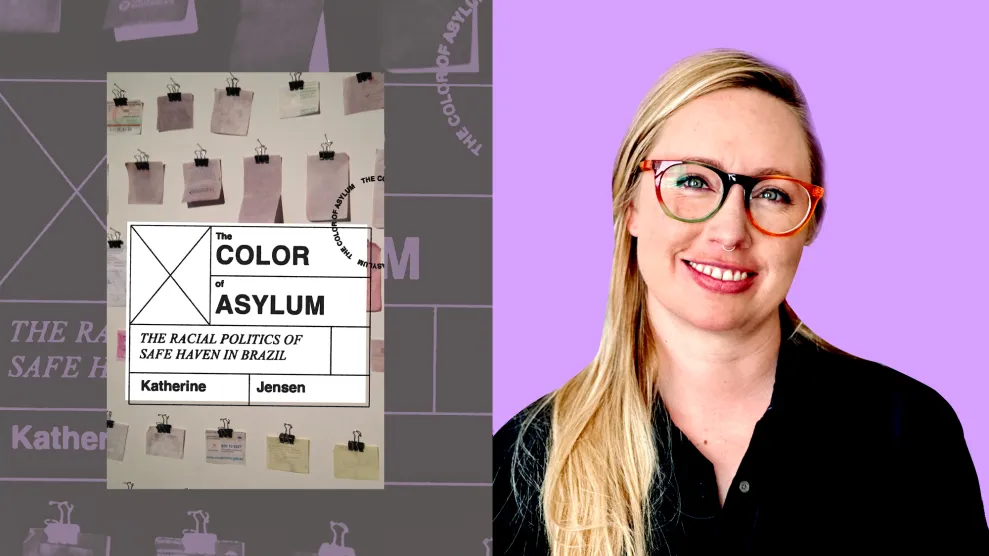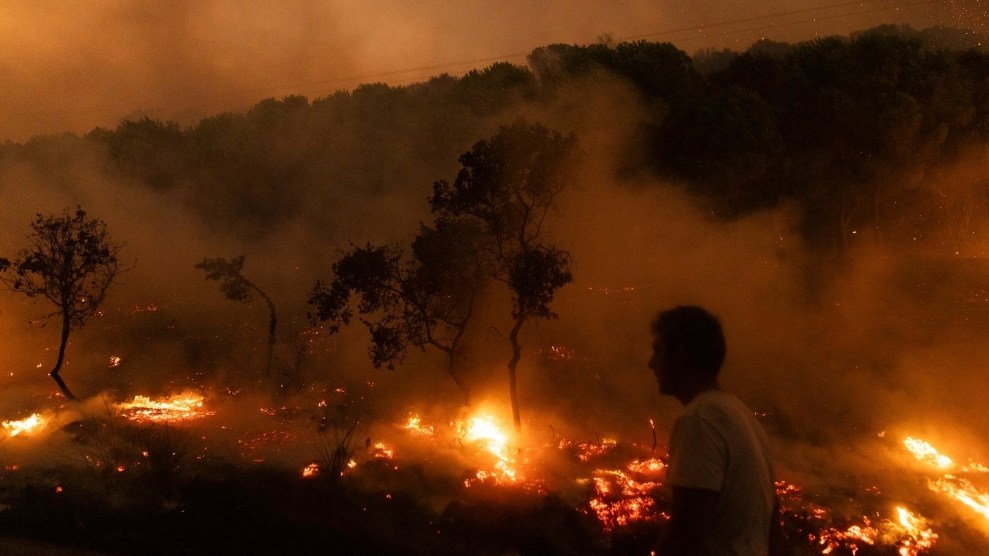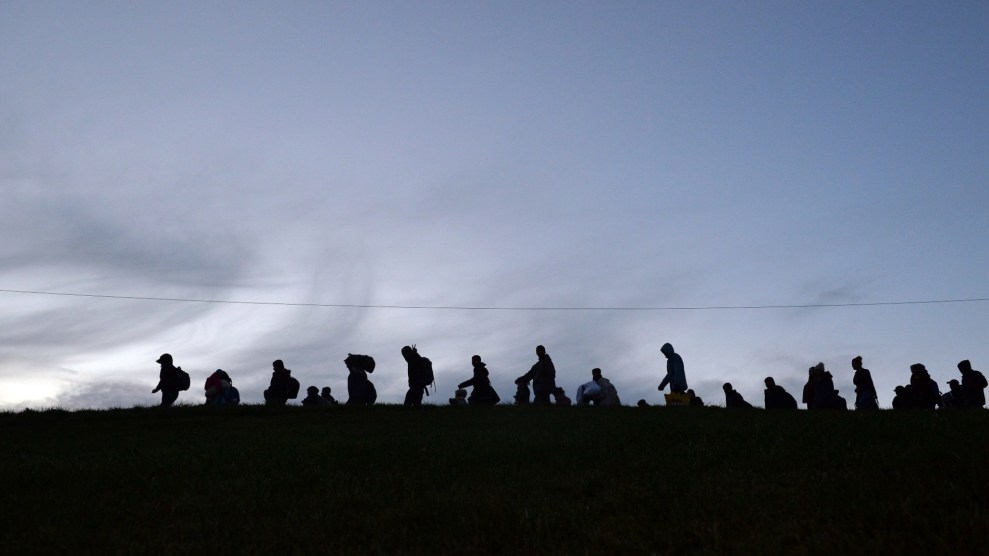
Katherine Jensen, author.Mother Jones illustration; The University of Chicago Press
A couple of months ago, four Nigerian stowaways traveled 3,500 miles above the rudder of a cargo ship all the way from Lagos to the southeastern coast of Brazil—without knowing where they were going. The stowaways were rescued by Brazilian authorities after 14 days at sea on a harrowing journey that echoed the forced trajectory of enslaved people during the Atlantic slave trade. Without food or water, the men told the New York Times, they licked toothpaste and drank seawater to hold on to life. Two of the stowaways chose to return to Nigeria, while the other two have applied for asylum in Brazil. “I pray the government of Brazil will have pity on me,” Roman Ebimene Friday told Reuters.
Brazil has a long-standing reputation as a leader in refugee protection and is a model in the Americas for welcoming asylum seekers. In 2013, Brazil implemented a policy making it easy for Syrian nationals fleeing conflict to seek protection in the country. By 2018, Brazil had become the sixth largest recipient of asylum claims.
But not all asylum seekers in Brazil are treated equally. In a new book published this month titled The Color of Asylum: The Racial Politics of Safe Haven in Brazil, Katherine Jensen, an assistant professor of sociology and international studies at the University of Wisconsin-Madison, offers a more complicated look at how different groups of asylum seekers, namely Congolese and Syrians, navigate the asylum process in South America’s largest nation.
Drawing from 15 months of fieldwork and interviews, Jensen documents how government officials evaluate asylum claims and the ways in which “migrants have the human right to seek asylum—but not to obtain it.” Mother Jones spoke with Jensen about the racialized notions of worthiness and belonging in the context of asylum and the lessons the United States can learn from a country as racially diverse as Brazil.
How did the idea for the book come about and why did you land on an ethnographic approach?
I was living in Argentina, and I was seeing all of these folks apply for asylum there who had a sense that they weren’t going to qualify, that ultimately their asylum claims would be denied, but they were still applying because it was a way, in the meantime, to have a right to legally live and work in the country. It was a context in which there wasn’t detention, there wasn’t a deportation regime. So many of my common sensical, ethnocentric ideas about how immigration control works based on the US context in which detention and deportation are fundamentally constitutive and ever present, it really made me think how differently immigration can work and does work in other places.
I started studying Portuguese when I was still living in Argentina and then in Brazil I started to do the work that would become this book. Over the course of that time, the people who were seeking asylum in Brazil went from being predominantly African, mainly from the Democratic Republic of the Congo to Syrian. I saw the the radical transformations that happened when, after the Syrian conflict emerged, Syrians became the number one forced displaced population and how everything about the asylum process changed—the nature of the reception to being extended visas to how quickly their cases were being processed and what those interviews looked like. That was when it became very clear to me that racial hierarchies and questions of racism were playing a key role in how this process was working.
One of the major points you make in the book is that states exercise “racial political domination” not only through legal exclusion but also through inclusion and even policies that are progressive on paper. How is that evident in Brazil, a country that unlike the United States, doesn’t detain or deport immigrants?
In the Brazilian context, so many of the ways that racism and racial hierarchies have been produced and reproduced has not been through formal legislation. Not only don’t you have explicitly racist policies, but instead you have explicitly anti-racist policies. But in everyday interactions there are forms of exclusion from social institutions. So Brazil is not a country that experienced Jim Crow segregation, that did not have formal racial segregation and discrimination in the ways that you see in countries like the United States or South Africa with a racial apartheid. It’s just not traditionally the mechanism through which racial hierarchies or political domination is played out. It is instead played out in these everyday practices and encounters in life as lived.
What parallels if any do you see between the racialized dynamics of the asylum systems in Brazil and the United States?
Both the United States and Brazil have these national myths of immigrant hospitality. In the United States, it’s the Statue of Liberty and the idea of being a nation of immigrants, whereas in Brazil, it’s this question of hospitality and welcome that continues to echo into the sort of Brazilian cordiality, including for migrant newcomers. There is a shared national ethos or imagined ethos vis-a-vis immigration and immigrants. In both the US and the Brazilian asylum system, a commonality you see is that both show that the state has the capacity to make migration easy. It has the capacity to make exemptions, to streamline certain cases, to provide entry, to provide pathways to citizenship, to provide permanent residency. Arabness is racialized very differently in the US context than in Brazil. In Brazil, the idea of Arabs or southwest Asians as being associated with terrorism or understood to be national security threats doesn’t map on with the US context because of different geopolitics and military interventions, and the roles that Islamophobia plays here. In both cases, you see some version of localized racial hierarchies in which anti-Blackness is a common thread. Whether we’re thinking about Haitians in the US context or Congolese in Brazil, the state is showing that it has the capacity to make things easier for asylum seekers and refugees and how and when it does so and chooses to do so is very much shaped by ideas of ethnoracial desirability.
How does the myth of racial democracy and the legacy of privileging white European immigration inform the ways race is perceived in Brazil and, as a result, the experience of different immigrant communities?
The Congolese refugees I met during fieldwork were largely coming from a racially homogeneous place where they understood themselves to be Black or knew themselves to be Black, but the way in which it structured the immediate society that they lived in, it didn’t have the same consequences. It didn’t shape their everyday lives, realities, and experiences in the way that they come to understand that it does in Brazil. It impacts the way that people talk to them at the federal police office or how they’re being treated at the social welfare office. But they come to see that blackness plays a huge role in the differential treatment and experience they have in Brazil in ways that was not a part of their everyday reality before fleeing and seeking asylum in Brazil. There’s a quote in the book from a Congolese refugee and he he says that before fleeing Congo for Brazil, he thought he was a man just like everybody else and he didn’t know that skin color made such a difference. In Brazil, he feels totally without identity and without voice.
Historically, Syrian Lebanese were understood as commercial peddlers, so they were seen as people who are able to be economically successful. The history of that association of Syrian Lebanese with economic entrepreneurship very much still undergirds and shapes how Syrian refugees in Brazil today are being seen and responded to. These ethnoracial stereotypes and frames about who these people are then means that Syrian refugees in general have been framed and discussed as more of an opportunity for Brazil than a burden. And that shapes how you think about what policies are sort of the open door policy that Brazil instituted in 2013 for Syrian refugees. But that has consequences. There was a gap between what they understood they needed to reconstruct a dignified life in Brazil, and what people assumed that they needed because of this idea that they would just make it work and figure it out on their own. What I found was Syrian refugees were really disenchanted by the the gap between the ease of their arrival in Brazil and how little infrastructural support or assistance existed.
In Brazil, most Congolese asylum seekers and Syrians have their asylum claims recognized. What were some of the ways you saw the treatment of Black African asylum seekers being different from that of Syrian asylum seekers?
In every key aspect of the process of seeking asylum, the experiences of Congolese and Syrian refugees vary. Syrian refugees were not interrogated in their interviews to try to decide whether they were credible and believable. They talked about their interviews for asylum as being friendly, conversational, and very short. Many Syrian refugees were not interviewed at all, they just had their cases fast-tracked, whereas Congolese and other Black African refugees would speak of that interview as the most difficult part of the process, or that it made them feel like a convict. Congolese claims are delayed years. It happens from how people arrive in the country to what the interview feels like to how long they have to wait in legal and socio economic precarity and emotional turmoil, and uncertainty. It also continues even after Syrian and Congolese refugees have received asylum. The main way that happens is through delays in the right to family reunification. All refugees in Brazil have the legal right to bring family members to Brazil to be reunited with them. But in practice, national data shows that Congolese refugees wait over 10 years longer to be reunited with their families than Syrian refugees do.
Are there any lessons the United States can learn from Brazil’s experience?
One is generally the denormalization and of the taken-for-grantedness of detention and deportation, and the criminalization of unauthorized entry. There’s still plenty of places—Brazil and many other countries in Latin America—that are not understanding unauthorized entry as being criminal or something worthy of deportation or even detention. Not all of the world is responding with increasingly doors or deterrence policies. There are other models that exist that at the minimum are less draconian.
Over 90 percent of folks who apply for asylum get asylum in Brazil; there’s no detention; there’s no deportation; applying for asylum gives you the right to work. Even if you address all of those things, there’s still plenty of ways for the state to reproduce racial political domination. As long as the state has the capacity to select, evaluate, screen, and differentiate among different types of migrants, you have the possibility and the space for the state to reproduce racial hierarchies amongst them. Maybe it’s worth thinking more seriously about open borders being the political project of focus as a way to limit the way that the state screens, evaluates, adjudicates, and classifies migrants.
















